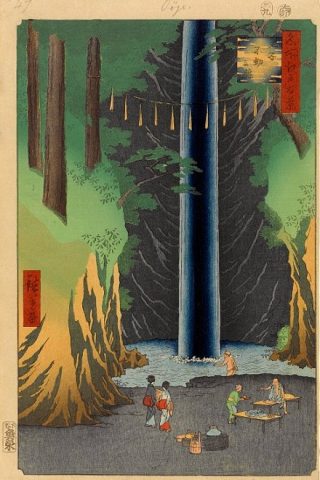
Hiroshige’s series entitled One Hundred Famous Views of Edo is categorized as a meisho-e. This genre substantlially reads “imagery of famous locations”, as previously reported with reference to both The Fifty–Three Stations of the Tōkaidō by the same author and Hokusai’s Thirty-Six Views of Mount Fuji.The genre under examination, born in the Heian period (794-1185) as an illustration of scenarios made famous by the poetry, had assumed the function to provide, in a time of growing traveling as that of the author, useful reproduction sets of famous destinations. Some of these – the artwork here illustrated is an informative example – were holy places where a large number of pilgrims paid visit.
The picture trenchantly conveys an impression of sacredness because of the downwardly directed gravitational force to which the masses of water are subject. They look to combine as to assume an overall cylindrical form masterfully rendered through the use of the bokashi, namely by shades of blue (from white to deep blue through a pale azure). Note that we are dealing with a prominent example of printing technique, successfully prone to give some painting effect, which was adopted by a restricted number of especially skilled masters. Specifically, Hiroshige’s artwork here depicted is an example of artistic abstraction: the author does not intend to reproduce a realistic waterfall, but instead he is inclined to figuratively express a sort of idealization of that physical notion. In comparison to Hokusai’s similar subject, where nature, and, in particular, water, is imagined and evoked through, that’s to say, jittery and vibrant outlines, Hiroshige’s one prefers being perceived as a purely canonical volume, as it is the case for the perfectly smoothed out columnar geometry of the falling water. The human figures at the waterfall foot are proportionally minute. A pair of umbrella-carrying gentlewomen with their luxuriant hairs, and smartly dressed with kimonos, are observing that mighty scenario while a half-naked pilgrim plunges into the pool surrounding the impacting area. An older woman, also included in that bounce of people, serves tea to a man, who just had a bath, stretching out the hand like he was trying to help her.
The monumental elements composing the scenery are accomplished by the vertical cliffs. Festoon hanging from the top of tree trunks, a sign of the sacredness of the place, almost seems both to gently frame the main subject and to give a sense of the vertical extension of the waterfall. The squared cartouche, in the top right of the printing, reporting the printing title is decorated with a stylized pattern of clouds.
Copyright © arteingiappone – All rights reserved
The picture is from: http://www.musubi.it/index.php/koryu/maestri/421-nobutsuna?showall=1&limitstart=